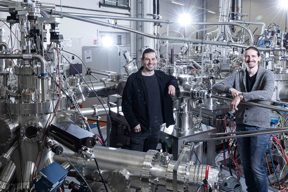Home > Press > First hybrid quantum bit based on topological insulators: Scientists at Forschungszentrum Jülich take an important step on the path towards topological quantum computers
 |
| Dr. Peter Schüffelgen (left) and Tobias Schmitt (right) in front of the NanoCluster at Forschungszentrum Jülich where core components of the hybrid qubit were fabricated in an ultra-high vacuum.
CREDIT Forschungszentrum Jülich / Sascha Kreklau |
Abstract:
With their superior properties, topological qubits could help achieve a breakthrough in the development of a quantum computer designed for universal applications. So far, no one has yet succeeded in unambiguously demonstrating a quantum bit, or qubit for short, of this kind in a lab. However, scientists from Forschungszentrum Jülich have now gone some way to making this a reality. For the first time, they succeeded in integrating a topological insulator into a conventional superconducting qubit. Just in time for “World Quantum Day” on 14 April, their novel hybrid qubit made it to the cover of the latest issue of the renowned journal Nano Letters.
First hybrid quantum bit based on topological insulators: Scientists at Forschungszentrum Jülich take an important step on the path towards topological quantum computers
Jülich, Germany | Posted on April 15th, 2022
Quantum computers are regarded as the computers of the future. Using quantum effects, they promise to deliver solutions for highly complex problems that cannot be processed by conventional computers in a realistic time frame. However, the widespread use of such computers is still a long way off. Current quantum computers generally contain only a small number of qubits. The main problem is that they are highly prone to error. The bigger the system, the more difficult it is to fully isolate it from its environment.
Many hopes are therefore pinned on a new type of quantum bit the topological qubit. This approach is being pursued by several research groups as well as companies such as Microsoft. This type of qubit exhibits the special feature that it is topologically protected; the particular geometric structure of the superconductors as well as their special electronic material properties ensure that quantum information is retained. Topological qubits are therefore considered to be particularly robust and largely immune to external sources of decoherence. They also appear to enable fast switching times comparable to those achieved by the conventional superconducting qubits used by Google and IBM in current quantum processors.
However, it is not yet clear whether we will ever succeed in actually producing topological qubits. This is because a suitable material basis is still lacking to experimentally generate the special quasiparticles required for this without any doubt. These quasiparticles are also known as Majorana states. Until now, they could only be unambiguously demonstrated in theory, but not in experiments. Hybrid qubits, as they have now been constructed for the first time by the research group led by Dr. Peter Schüffelgen at the Peter Grünberg Institute (PGI-9) of Forschungszentrum Jülich, are now opening up new possibilities in this area. They already contain topological materials at crucial points. Therefore, this novel type of hybrid qubit provides researchers with a new experimental platform to test the behaviour of topological materials in highly sensitive quantum circuits.
####
For more information, please click here
Contacts:
Tobias Schloesser
Forschungszentrum Juelich
Office: +49-246-161-4771
Expert Contacts
Tobias Schmitt
Forschungszentrum Jülich, Peter Grünberg Institute, Semiconductor Nanoelectronics (PGI-9)
Office: +49 2461 61-85417
Dr. Peter Schüffelgen
Forschungszentrum Jülich, Peter Grünberg Institut, Semiconductor Nanoelectronics (PGI-9)
Office: +49 2461 61-85250
Prof. Dr. Detlev Grützmacher
Forschungszentrum Jülich, Head of the Peter Grünberg Instituts, Semiconductor Nanoelectronics (PGI-9)
Office: +49 2461 61-2340
Copyright © Forschungszentrum Juelich
If you have a comment, please Contact us.
Issuers of news releases, not 7th Wave, Inc. or Nanotechnology Now, are solely responsible for the accuracy of the content.
News and information
![]()
Scientists develop indoor-active photocatalyst for antiviral coating against various variant types of novel coronavirus SARS-CoV-2 April 15th, 2022
![]()
Flexible quantum sieve made at TU Dresden filters the fuel of Starship Enterprise April 15th, 2022
![]()
Photocatalysts with built-in electric field helps to remove pollutants from water April 15th, 2022
![]()
Achieving higher performance with potassium ion battery April 15th, 2022
Possible Futures
![]()
Scientists develop indoor-active photocatalyst for antiviral coating against various variant types of novel coronavirus SARS-CoV-2 April 15th, 2022
![]()
Flexible quantum sieve made at TU Dresden filters the fuel of Starship Enterprise April 15th, 2022
![]()
Photocatalysts with built-in electric field helps to remove pollutants from water April 15th, 2022
![]()
Achieving higher performance with potassium ion battery April 15th, 2022
Chip Technology
![]()
USTC found a pathway to high-quality ZnSe quantum wires April 8th, 2022
![]()
First integrated laser on lithium niobate chip: Research paves the way for high-powered telecommunication systems April 8th, 2022
Quantum Computing
![]()
Could quantum technology be New Mexicos next economic boon? Quantum New Mexico Coalition aims to establish state as national hub April 1st, 2022
Discoveries
![]()
Delivery systems of plasmid DNA and messenger RNA for advanced therapies April 15th, 2022
![]()
Injectable stem cell assembly for cartilage regeneration April 15th, 2022
Announcements
![]()
Scientists develop indoor-active photocatalyst for antiviral coating against various variant types of novel coronavirus SARS-CoV-2 April 15th, 2022
![]()
Flexible quantum sieve made at TU Dresden filters the fuel of Starship Enterprise April 15th, 2022
![]()
Photocatalysts with built-in electric field helps to remove pollutants from water April 15th, 2022
![]()
Achieving higher performance with potassium ion battery April 15th, 2022
Interviews/Book Reviews/Essays/Reports/Podcasts/Journals/White papers/Posters
![]()
Scientists develop indoor-active photocatalyst for antiviral coating against various variant types of novel coronavirus SARS-CoV-2 April 15th, 2022
![]()
Flexible quantum sieve made at TU Dresden filters the fuel of Starship Enterprise April 15th, 2022
![]()
Photocatalysts with built-in electric field helps to remove pollutants from water April 15th, 2022
![]()
Achieving higher performance with potassium ion battery April 15th, 2022










